Dental Fillings and Restorations
Restorative treatment can help prevent further damage and preserve your natural teeth. Dental fillings are often used to repair minimal tooth fractures, tooth decay, or damaged surfaces of the teeth for better biting or chewing. Those with tooth sensitivity will notice a significant improvement post dental fillings.
Dental Fillings and Restorations are minimally invasive procedures to improve the overall function and aesthetics of your teeth. At our North Sydney practice we aim to use the least invasive options whenever possible. Using the latest adhesive technologies, techniques and materials we are often able to avoid major dental surgery whilst still achieving a natural and durable look. There are multiple dental materials that we utilise to accommodate the variations in dental cavities.
North Sydney Dental – White Dental Fillings
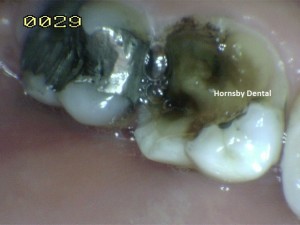
Patient had a severely decayed and broken down tooth.
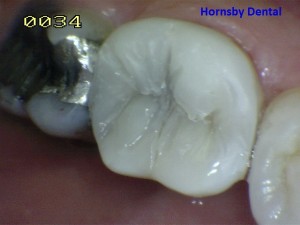
Result of the direct restoration, with both the function and aesthetics of the tooth back to normal.
North Sydney Dental Clinic –White Dental Fillings
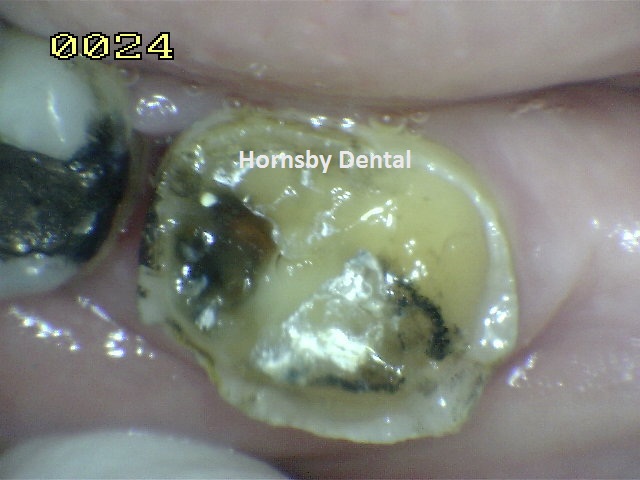
Severely decayed and broken down tooth, which is basically at the gum line, with virtually no function.
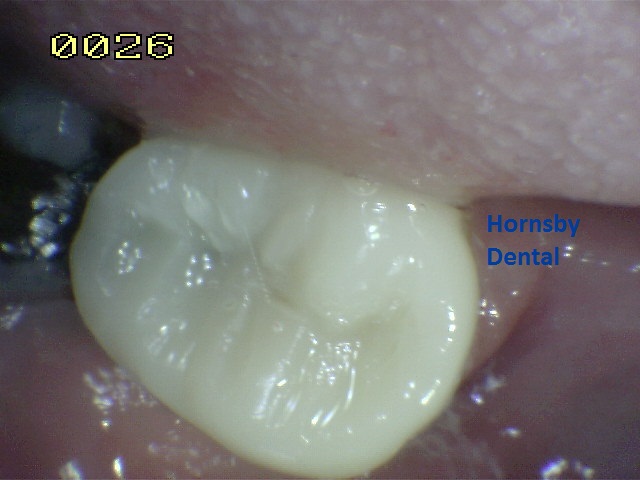
Result of the direct restoration, with both the function and aesthetics of the tooth back to normal. The patient was very happy with the final result.
North Sydney Cosmetic Dentist – Amalgam Fracture example
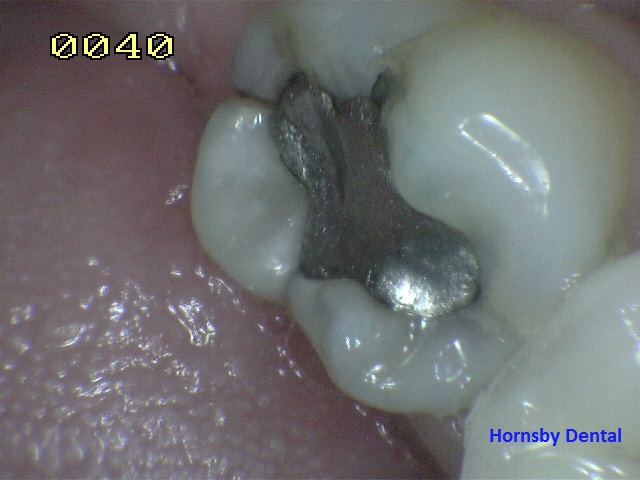
Old silver/amalgam filling that appears to have no apparent problem, however our close examination reveals fracture-lines running across the tooth.
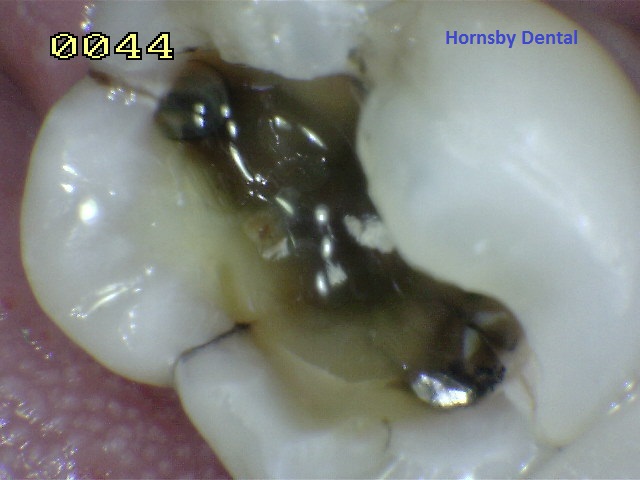
Deep recurrent decay accompanied by clearly visible fracture line. Amalgam restorations that have a high mercury content may behave like mercury in a thermometer – expands when termperature rises (hot food and drinks), and shrinks when cold. This can result in cracks of the tooth that is housing the amalgam.
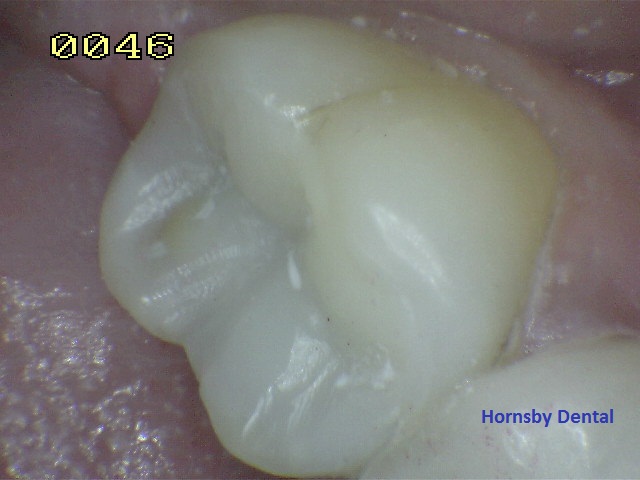
Immediately after amalgam replacement, the tooth is fully functional and highly aesthetic. However given the deep crack that is present underneath the restoration, the tooth is best to have a crown to minimise the risk of tooth fracture.
We do not offer Amalgam at our North Sydney Practice. There are multiple dental materials available at our practice. The type of material utilised is dependent on the size of the cavity present. Cavities vary greatly in size and it is our philosophy that some materials are more adequate than others depending on the size of the cavity. For example, glass ionomer cement is used for small cavities and composite resin is used for all sizes. You can speak to one of our friendly dentists at North Sydney Dental Care to find out which material would be most suitable for you.
Small cavities
For patients presenting with small cavities Glass ionomer cement is most often used. This material is a fluoride releasing material that lowers the risk of any future decay. Glass ionomer cement possesses excellent protective properties. It is slightly weaker than material used in larger cavities, however if overtime the restoration is wearing down or chipped away further materials can be applied with simplicity
All sizes of cavities
Composite resin is the most common restorative material used in modern dentistry. It is used to repair cavities of all sizes, and provides patients with excellent aesthetics and functional capacity. It is essential that patients practice good home oral care once the procedure is complete as overtime composite resin can became stained or chipped just like a regular tooth. Further repair to restorations created with composite resin is often simple as long as the new decay has not formed around the cavity. It is important to have regular check-ups with your dentist for this reason.
Larger sized cavities
Large sixed cavities are often best treated using composite/porcelain onlay. This material combines strength and beauty in one. Aesthetically, there are minimal differences when the material is compared to composite resin and glass ionomer cement. However it is the materials durability that sets it at the forefront of restorative procedures in modern dentistry.
Dental decay can form from a number of reasons. Decay is a bacterial infection process that weakens the tooth structure as it digs in deeper and deeper into the tooth, eventually hitting the pulpal chamber where the tooth’s nerve lies. When this happens, severe dental pain can occur, and root canal therapy or tooth removal may be inevitable.
To avoid this from happening, a dental restoration / tooth filling can be placed after the removal of decay before it hits the nerve. Dental fillings North Sydney can be made of several different materials. Your dentist will discuss with you the suitable restorative material.
Amalgam
Traditional alloy filling that has been around for a long time. It is durable and less technique sensitive to place in the cavity, but aesthetic of an amalgam filling is still considered inferior to other restorative material. Some people are concerned about mercury toxicity, but to date insufficient clinical evidence is available to support this concern. We do not place amalgam fillings anymore in our surgery, purely as a business decision, and we offer tooth-coloured alternatives to amalgam fillings.
Glass Ionomer Cement/GIC
Glass Ionomer Cement was developed as a “smart” material that is fluoride releasing and self-adhesive to the tooth structure. It is often used as a base or liner at the base of a deep cavity, or in shallow/early decays. It is a great material for patients with high-decay risks as it releases fluoride to resist against new decay. The drawback of this material however, is that it is not as wear-resistant as most other dental materials, making it a short to medium term restoration. It can be re-layered with other materials once it is worn down though.
Composite Resin
Composite Resin is a highly versatile dental restorative material that can be used in just about all situations. It consists of a resin matrix with microscopic/nano ceramic particles embedded in it. It is more wear resistant than GIC, and more aesthetic than both GIC and amalgam. It can be used in small, medium, to large cavities. However in larger cavities, because the resin matrix suffer a material shrinkage once it is cured/hardened, microscopic voids can lead to bacterial infiltration after a number of years. Ceramic: Modern ceramic restorations is highly durable and aesthetic. It costs more than other dental materials, however its durability and aesthetic out-perfoms most other restorative materials. There is no shrinkage like composite resin and minimal theramal expansion compared to amalgam restorations.
A local anaesthetic will be used by the dentist, to numb the surrounding area of the tooth. This part could be a little uncomfortable. Decayed areas will then be removed with either a drill, air abrasion instrument or laser. Once removed, the cavity will be cleaned and remove bacteria. Material will be added to protect the nerve if necessary before the filling is in.
To book an appointment or ask us any questions:
Feel free to speak to one of the friendly team at North Sydney Dentistry on 8090 1108, visit our practice at Level 1, Suite 102/71 Walker Street, North Sydney or e-mail us on info@northsydneydentistry.com.au.

